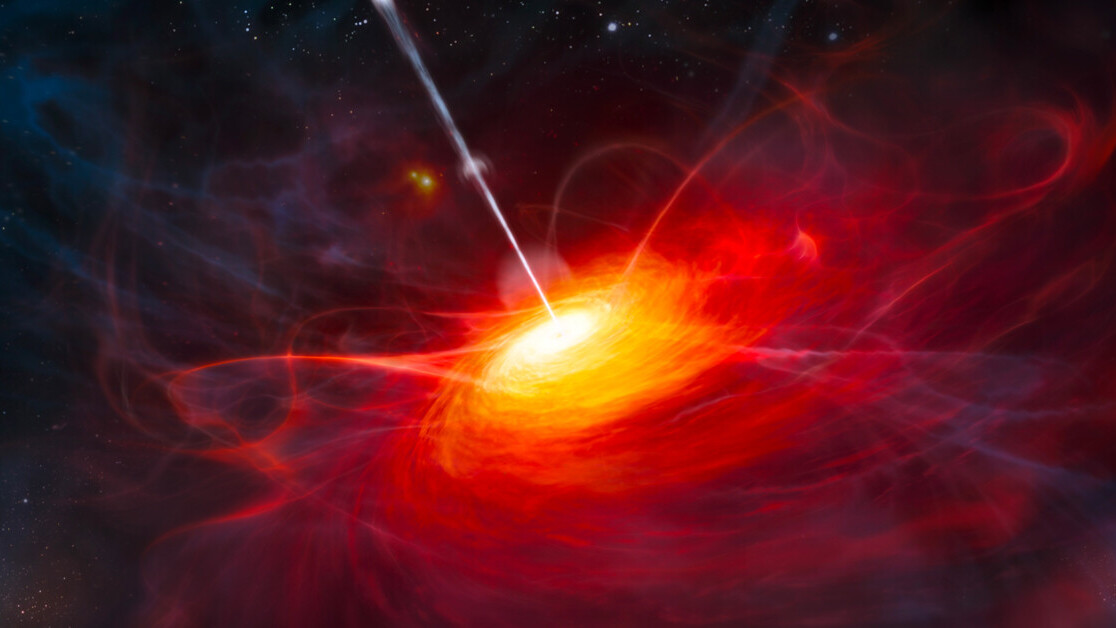NASA’s Chandra Observatory recently spotted an enormous jet racing away from a supermassive black hole in the ancient Universe. If confirmed by other studies, this could be the most distant object of its type ever seen by astronomers.
Located 12.7 billion light-years from Earth, this supermassive black hole, PSO J352.4034–15.3373 (or PJ352–15) could help explain how these objects formed in the early Universe. This ultradense body sits at the center of a young galaxy, forming a quasar.
Roughly a billion times more massive than the Sun, PJ352–15 is one of the most powerful quasars yet seen in the first billion years after the Big Bang. Astronomers are uncertain how supermassive black holes could grow so quickly in the early Universe, and PJ352–15 could help answer the question.
[Read: How do you build a pet-friendly gadget? We asked experts and animal owners]
Understanding the gravity of the situation
In the video above, take a look at the ancient quasar PJ352–15. (Video credit: Chandra X-ray Observatory).
Despite their popular image, black holes do not draw material directly into their clutches before slowly digesting their prey like an interstellar sarlaac. Material orbiting a black hole needs to lose energy and speed before falling past the event horizon — the “point of no return for material falling into a black hole.
Magnetic fields can result in braking forces, stealing energy from material orbiting a black hole. As this material falls inward, black holes gain mass.
“If a playground merry-go-round is moving too fast, it’s hard for a child to move towards the center, so someone or something needs to slow the ride down. Around supermassive black holes, we think jets can take enough energy away so material can fall inward and the black hole can grow,” explained Thomas Connor of NASA’s Jet Propulsion Laboratory (JPL).
Wave after wave
“A lot of the things you see in science fiction revolve around black holes because black holes are strong enough to rip the fabric of space and time.” — Michio Kaku
Observations of PJ352–15 and its quasar jet were taken over three days, using the Chandra X-ray telescope in orbit over Earth. This spaceborne observatory spotted X-rays from the quasar shooting 160,000 light years from the center of the quasar — a distance 60% longer than the Milky Way is wide. Radio waves seen from the jet did not extend nearly as great of a distance.
This is, far and away, the longest such jet ever observed emanating from a quasar seen from the first billion years after the Big Bang. The previous record-holder had a jet just 5,000 light-years long.
In the video below, we are examining galaxies orbiting an ancient quasar. (Video credit: The Cosmic Companion)
“The length of this jet is significant because it means that the supermassive black hole powering it has been growing for a considerable period of time. This result underscores how X-ray studies of distant quasars provide a critical way to study the growth of the most distant supermassive black holes,” explains Eduardo Bañados of the Max Planck Institute for Astronomy (MPIA).
The quasar PJ352–15 is also 300 million light years further from us than the most distant similar object known. When the light seen today by Chandra left its source, the Universe was less than a billion years old. At that time, the energy we now see as the cosmic microwave background radiation (CMB) was far more intense than we see in the modern Universe.
Analysis of the study will be published in The Astrophysical Journal.
This article was originally published on The Cosmic Companion by James Maynard, founder and publisher of The Cosmic Companion. He is a New England native turned desert rat in Tucson, where he lives with his lovely wife, Nicole, and Max the Cat. You can read this original piece here.
Astronomy News with The Cosmic Companion is also available as a weekly podcast, carried on all major podcast providers. Tune in every Tuesday for updates on the latest astronomy news, and interviews with astronomers and other researchers working to uncover the nature of the Universe.
Get the TNW newsletter
Get the most important tech news in your inbox each week.





